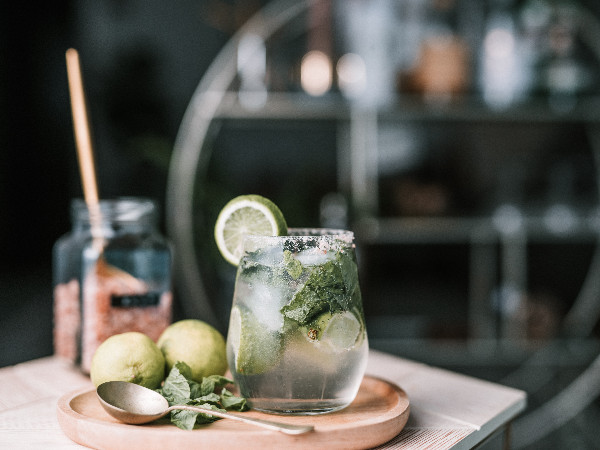Lead photo by Lucie Liz
I had my first mojito in Louisville, Kentucky, of all places. My husband and I decided to try a Cuban restaurant that a friend had recommended and, even though I have long since moved away and haven’t been since 2012, I can honestly say that Havana Rumba (now called Mojito in Havana) might still be one of my most favorite restaurants. That evening, I had the café con leche martini because, with Cuban coffee in it, how could that not be delicious? (It was, in fact, amazing and I also highly recommend it if you ever get to go.) My husband on the other hand, had a mojito and it was magical: mint leaves swirling in the rum and club soda, dancing around the ice cubes, served with as much lime as the rim of that Collins glass could manage and a stick of actual sugar cane! Every time we returned to Havana Rumba, we each had to have at least one of those glasses of delicious sorcery.

Photo by Taryn Elliott: mojito with sugared rim on a wooden serving tray with whole limes, tray is sitting on a wooden surface; a circular shelf used as a bar is out of focus in the background.
July 11th is National Mojito day and today we honor that ambrosiac beverage that, at least according to legend, was a favorite of writer—and famed drinker—Earnest Hemingway. As most is appropriate for anything associated, even tangentially, with that controversial personality, the story of the mojito is muddled and contradictory. So far as I can tell, there are three distinct, often told histories of the mojito. Each of the three, though, begin with aguardiente—an evolutionary predecessor to rum. Aguardiente is a name applied to many different distilled liquors, made with a wide variety of ingredients, across Spain, Portugal, Latin America and the Caribbean islands. In this case, we’re talking about aguardiente de cana—made from fermented sugar cane—which was produced in the Caribbean.
Description: this video shows sugar cane juice production—from harvest to cup—by roadside vendors in India, using a process largely unchanged for the last two centuries. The cane is harvested, cleaned, and then pushed through a human-powered press to squeeze the juice from the cane. The video is, unfortunately, silent.
One story claims that people indigenous to the Caribbean islands had long been making a medicine from aguardiente. That medicine explained to the Europeans in the process of colonization why the indigenous people didn’t suffer from scurvy or dysentery. In this particular history, the story goes that Sir Francis Drake made port in Havana, on one of his raids on the Spanish colonies, and sent a party to shore to seek some of this medicine for his crew, who were rapidly dying of… scurvy and dysentery. The party returned with ingredients given to them by the indigenous Cubans to make a medicinal tonic: aguardiente de cana, spearmint, limes, and sugar cane. Considering this story also claims that a cocktail combining those ingredients and known as “El Draque” became popular in Cuba afterward, I would largely consider this story apocryphal. “El Draque” or Franciscus Draco is what Drake was called by the Spanish who labeled him (correctly, in spirit) a pirate, so I’m sure that name was uttered often in 16th century Cuba; I am not so sure that it was uttered as the name of a cocktail on a Spanish-occupied island where indigenous people had already been making it.
Another story claims that the mojito was invented by enslaved Africans enduring the brutal and torturous regime of chattel slavery. In this version, enslaved Africans learned from enslaved indigenous people about guarapo—sugar cane juice—which you could drink for energy or ferment it into an alcoholic beverage (aguardiente de cana). The Africans added mint and it was called “mojito”—from the root “mojo”—meaning “cast a little spell.” This is also likely apocryphal; even the origin of the name isn’t agreed upon: did it come from African mojo? or was it named for the lime-y Cuban seasoning “mojo?” does the name simply derive from the Spanish “mojadito,” meaning “a little wet?” No one really knows.
via GIPHY: a .gif of Robert Downey Jr. looking at something intently before putting it down and saying “I dunno.”
A different story simply asserts that the cocktail came about in a natural progression stemming from trying to make barely-potable rum palatable. Maybe the mojito’s true history lies in between all of these origin stories; maybe it’s a little bit of each. Actually, it’s almost definitely a little bit of each. The colonization of the Caribbean and the Americas and the trans-Atlantic slave trade forced cultures together, learning from one another how to survive the brutal conditions imposed by the colonial plantation owners—including sharing recipes for energy tonics or an alcoholic beverage to help treat pain. And pirates and rum runners had to have learned it from people on the islands where they made port and then disseminated the information through their travels. The history of the mojito is muddled because history itself is muddled.
In any case, mojitos enjoyed a rapid popularization during Prohibition in the US, when Cuba became a very desirable travel destination for Americans wanting to get their drink on. Its popularity has waxed and waned in the century since but it has remained a mainstay on cocktail menus and with at-home bartenders. It is an easy cocktail to prepare, it is simple to change up, and its flavor profile is light and bright and …well, it tastes like summer!

Photo by alleksana: 4 mojitos on a metallic tray sitting on a white table top, a wood cutting board with lime wedges on it sits in the background; the shadow of a plant stretches across the scene.
In celebration of the mojito—summer magic in a glass—I’ve dug up a few recipes that I think you’ll enjoy!
Sloppy Joe’s Mojito is the first mojito recipe to make it into print with the name “mojito.” Though the recipe I’ve linked here is from 1947, that first printed recipe appears in Sloppy Joe’s Cocktail Manual in 1932. This is the kind of mojito enjoyed by Hemingway and Clark Gable in Havana.
My friend and I, just today, picked up a thirty-ish pound watermelon at our local fruit stand that we’re going to split and I am absolutely going to try this watermelon mojito! I love summer flavors so much and I cannot wait to try two of my favorites together! And speaking of summer flavor combinations, if you’re mixing up some cocktails to share, this pitcher strawberry mojito recipe might be exactly what you need. If you’re mixing for a party, try to make it inclusive: this mango nojito and this pear nojito are refreshing, summery drinks that can be enjoyed by everyone!

Photo by Taryn Elliott: an outstretched hand holds a mojito in the light of sunset; taken at the beach, the water stretches along the right side, a spit of land and mountain foothills appear in the background.
There are variations that would also be ideal for the cooler months, like this winter mojito; while it definitely requires more prep, I do like how customizable the flavor profile is! I want to try that this winter with some cranberries and orange slices—I think that would end up being a delightful holiday libation. Switching out the spiced rum and liqueur for some non-alcoholic mulled cider would make it a great, all-ages drink to enjoy around a fire pit or in front of the fireplace
And there are just so many more variations out there! It’s almost endlessly customizable: change out the mint for basil; forego the limes and use a lavender simple syrup; try switching up the citrus and herb pairings—like grapefruit and thyme or orange and rosemary! The possibilities are myriad and exciting
So, Happy National Mojito Day and I wish you many delicious mo/nojitos in your future!

A .gif of a drink being poured into a Collins glass next to an already full glass; the drink is green; the glasses sit in front of a lime green background and on top of a lime green surface; the glasses are surrounded by a mint sprig, a slice of lime, a drinking straw, and several toy dinosaurs.
Try to be inclusive, y’all; remember not everyone drinks alcohol. Don’t pressure them and don’t ask why, it really doesn’t matter and it’s none of your business.
And, as always:









Leave a Reply